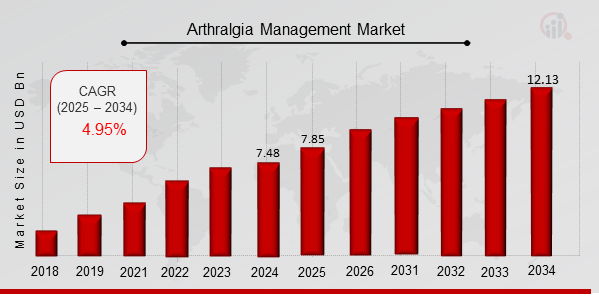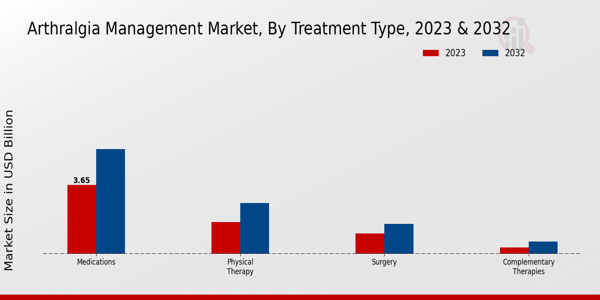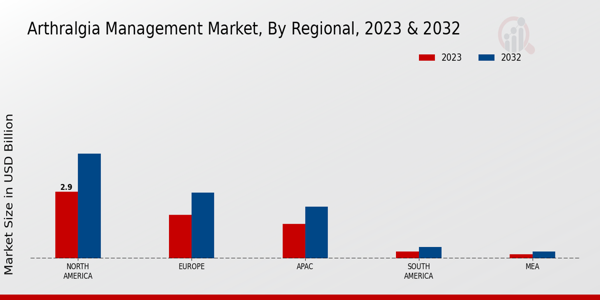Global Arthralgia Management Market Overview
As per MRFR analysis, the Arthralgia Management Market Size was estimated at 7.48 (USD Billion) in 2024. The Arthralgia Management Market Industry is expected to grow from 7.85 (USD Billion) in 2025 to 12.13 (USD Billion) till 2034, at a CAGR (growth rate) is expected to be around 4.95% during the forecast period (2025 - 2034).
Key Arthralgia Management Market Trends Highlighted
The Arthralgia Management Market is seeing significant growth driven by the increasing prevalence of joint-related disorders and the rising aging population. Patients are increasingly seeking effective pain management solutions, which fuels the demand for both pharmaceutical and non-pharmaceutical interventions. Advances in research and development also contribute significantly to this trend, offering new drug formulations and treatment options that prioritize patient well-being and comfort. Additionally, heightened awareness of arthralgia has led to better diagnosis and treatment referrals, further accelerating market growth. Opportunities are ripe for exploration in the realm of personalized medicine and biotechnology.Companies can capture market share by developing targeted therapies that address the unique needs of patients. There is also a growing interest in integrative approaches that combine conventional treatments with alternative therapies, such as physical therapy and acupuncture. Furthermore, as telemedicine gains traction, remote monitoring and consultations provide new avenues for patient engagement and adherence to treatment plans. This shift not only improves patient access but may also enhance overall outcomes. Recent trends indicate a movement towards more holistic and patient-centered care strategies in arthralgia management. Digital health tools, such as mobile applications that track symptoms and treatment efficacy, are becoming increasingly popular, allowing for better patient involvement and management.Moreover, there is an observable shift towards preventive care, with many initiatives focusing on lifestyle changes to mitigate the onset of joint issues. As the landscape evolves, healthcare providers are placing a greater emphasis on collaborative care models, which facilitate a comprehensive approach to managing arthralgia and improving the quality of life for patients. This evolving marketplace highlights the importance of innovation and adaptability in addressing the complex needs of those affected by joint pain.

Source: Primary Research, Secondary Research, MRFR Database and Analyst Review
Arthralgia Management Market Drivers
Increasing Prevalence of Arthralgia Conditions
The rising incidence of arthralgia and related joint disorders is a significant driver influencing the Arthralgia Management Market Industry. Aging populations globally are contributing heavily to this trend, as age-related conditions often lead to greater instances of arthralgia. As individuals live longer, the likelihood of developing chronic joint conditions increases, leading to a heightened demand for effective management solutions. Furthermore, a greater awareness and diagnosis of these conditions, thanks to improved medical knowledge and health resources, have led to more people recognizing their symptoms and seeking treatment options.This increase in patient awareness has sparked greater demand for innovative therapies, medications, and management strategies within the market, thereby driving growth. In addition, global lifestyle changes, such as increased obesity rates and sedentary habits, are contributing to joint pain issues. As these lifestyle factors continue to rise, it’s expected that more individuals will require arthralgia management solutions, ensuring robust market growth in the coming decade.The push for personalized medicine in arthralgia management also highlights the unique needs of different patient demographics, emphasizing the value of tailored solutions. Thus, the convergence of demographic trends, improved health literacy, and lifestyle choices significantly influences market dynamics, propelling the expansion of the Arthralgia Management Market Industry in both the short and long term.
Advancements in Treatment and Management Options
The development of advanced treatment options has emerged as a prominent driver in the Arthralgia Management Market Industry. Innovations in medication, such as biologics, disease-modifying antirheumatic drugs (DMARDs), and personalized therapies, are revolutionizing the approach to managing arthralgia. As pharmaceutical companies invest heavily in research and development, the introduction of more effective and targeted treatments improves patient outcomes and increases the demand for these products.The focus on minimally invasive procedures, alongside physical therapy and rehabilitation techniques, further enhances the portfolio of management options available to practitioners and patients alike. These advancements cater to a wide range of patient needs, promoting a better quality of life and fueling market growth.
Robust Investment in Healthcare Infrastructure
A robust investment in healthcare infrastructure, especially in developing regions, is presenting new growth opportunities within the Arthralgia Management Market Industry. Governments and healthcare organizations are increasingly prioritizing the improvement of healthcare facilities and services, which encompasses pain management and rehabilitation sectors. As healthcare access improves, more individuals will be able to seek diagnosis and treatment for arthralgia, leading to an expanded market.Investment in education and training programs for healthcare professionals is also critical, ensuring that practitioners are well-equipped to provide optimal care and manage treatments effectively. This investment creates an empowered healthcare workforce, ultimately supporting the increasingly sophisticated needs of arthralgia patients.
Arthralgia Management Market Segment Insights:
Arthralgia Management Market Treatment Type Insights
The Arthralgia Management Market is being notably shaped by its Treatment Type segment, which encompasses various approaches to address arthralgia or joint pain, a condition affecting a significant portion of the population. In 2023, the global market is valued at approximately 6.79 USD Billion. Among the various approaches to treatment, medications hold a major position, valued at 3.65 USD Billion, which indicates a significant demand for pharmacological interventions in pain management and inflammation reduction. This segment's dominance is attributed to the increasing prevalence of chronic pain conditions, driving the need for effective medicinal solutions. Following medications, physical therapy emerges as another essential component, valued at 1.7 USD Billion in 2023. This therapeutic approach is recognized for its role in improving joint function and mobility through structured exercise and rehabilitation techniques, emphasizing the importance of non-invasive treatments in managing arthralgia. Surgery, while less frequently pursued, also plays a critical role with a valuation of 1.1 USD Billion in 2023. Surgical intervention is typically considered for cases where other treatments have failed or in instances of severe structural joint damage, thereby contributing to the overall management of arthralgia. Lastly, complementary therapies, valued at 0.34 USD Billion, represent an emerging aspect of treatment, integrating holistic and alternative approaches aimed at alleviating symptoms and improving quality of life. Although this segment currently holds the lowest valuation, it is gradually gaining traction among patients seeking supplemental care options outside traditional medicine as individuals increasingly value comprehensive management strategies that address their overall well-being. In analyzing the Arthralgia Management Market data, it’s evident that the medications segment maintains a majority holding and is a significant driver due to the reliance on pharmaceutical interventions, while physical therapy represents a viable and effective alternative that underscores the market's inclination towards a balanced approach combining both conventional and rehabilitative methods. The growth within this market can also be attributed to factors such as increasing awareness regarding arthralgia, advancements in treatment technologies, and a surge in the aging population, all contributing to a sustained demand for diverse treatment options in the coming years. Thus, the market's landscape continues to evolve as healthcare professionals and patients alike seek more effective and personalized management strategies, which will likely enhance the overall Arthralgia Management Market statistics and industry dynamics as projected valuations reach 10.5 USD Billion by 2032.

Source: Primary Research, Secondary Research, MRFR Database and Analyst Review
Arthralgia Management Market Route of Administration Insights
The Route of Administration segment within the Arthralgia Management Market is crucial, as it directly influences treatment efficacy and patient compliance. In 2023, the market will be valued at 6.79 billion USD, reflecting a growing demand for diverse administration routes that enhance the therapeutic experience for patients. Among these, oral administration remains prominent due to its convenience and ease of use, making it a preferred choice for many patients managing arthralgia. Topical formulations are also significant, offering targeted relief with minimal systemic side effects, which appeals to those seeking more localized treatment options.
Additionally, injectable routes, though less common, play an important role in delivering rapid relief and higher concentrations of medication directly into affected areas. The segmentation of the Arthralgia Management Market, including these administration routes, showcases the industry's adaptability in responding to patient needs and preferences. As the market evolves with changing healthcare trends and emerging therapies, the focus on optimizing these routes of administration will drive growth and improve patient outcomes, aligning with the broader Arthralgia Management Market statistics and expectations.
Arthralgia Management Market Distribution Channel Insights
The Arthralgia Management Market revenue is primarily distributed across various distribution channels, including Hospital Pharmacies, Retail Pharmacies, and Online Pharmacies. In 2023, the overall market was valued at 6.79 billion USD, exhibiting the rising demand for effective arthralgia treatments. Hospital Pharmacies play a crucial role as they are often the first point of care, providing specialized medications directly associated with clinical treatments. Retail Pharmacies offer wide accessibility and convenience, making them popular among patients looking for immediate relief options.
Online Pharmacies gained significant traction due to the growing reliance on e-commerce, allowing patients to order medications from the comfort of their homes, thus driving market growth. The expansion of online platforms has been fueled by advancements in technology and increased internet penetration, catering to a broader audience. The selection of distribution channels influences the overall accessibility of arthralgia management products, impacting various factors such as consumer preferences and the market’s adaptability to new trends. The Arthralgia Management Market statistics reveal a dynamic landscape that is shaped by changing patient behaviors, market growth opportunities, and shifting trends in pharmaceutical distribution.Arthralgia Management Market Severity of Condition Insights
The Arthralgia Management Market, valued at 6.79 USD billion in 2023, showcases an intricate segmentation based on the Severity of Condition, comprising Mild, Moderate, and Severe categories. This segmentation is crucial as it directly impacts treatment approaches and market demands. Mild cases often lead to a significant portion of the overall market due to their prevalence and the necessity for management solutions that focus on lifestyle modifications and over-the-counter medications. Moderate-severity cases typically require a more comprehensive treatment plan, including prescription medications, thus representing a significant opportunity for market growth.
Severe cases pose substantial challenges, often leading to greater healthcare costs and necessitating advanced therapies, which dominate the market. As healthcare providers increasingly emphasize personalized treatment strategies, the understanding of each severity level's needs drives innovation in the Arthralgia Management Market, contributing to the overall market growth. The evolution of therapeutic options and a growing aging population are key drivers enabling increased demand within these segments, enriching the Arthralgia Management Market statistics and future potentials.
Arthralgia Management Market Regional Insights
The Arthralgia Management Market is projected to achieve a market value of 6.79 USD Billion in 2023, with the regional segmentation revealing significant variations across different areas. North America leads the market with a valuation of 2.9 USD Billion, expected to rise to 4.55 USD Billion by 2032, highlighting its majority holding due to advanced healthcare infrastructure and ongoing research. Europe follows closely, valued at 1.9 USD Billion in 2023 and projected to grow to 2.85 USD Billion, driven by an increasing elderly population.
APAC, with a valuation of 1.5 USD Billion in 2023, stands at a notable growing stage, reflecting the region's rising healthcare demands and awareness, aiming for 2.25 USD Billion in 2032. South America and MEA, although smaller in size, are steadily developing markets, with values of 0.3 USD Billion and 0.19 USD Billion in 2023, respectively, showcasing the potential for growth as healthcare accessibility improves. The diversification of the Arthralgia Management Market segmentation indicates various growth drivers and challenges across regions, presenting both opportunities and complexities in addressing the needs of arthralgia patients globally.

Source: Primary Research, Secondary Research, MRFR Database and Analyst Review
Arthralgia Management Market Key Players and Competitive Insights:
The Arthralgia Management Market has witnessed a significant evolution in recent years, driven by an increasing prevalence of joint pain and a growing awareness of treatment options. Competitive insights within this market reveal a landscape characterized by a myriad of pharmaceutical companies and innovative therapies aimed at addressing arthralgia or joint pain. Companies are engaged in extensive research and development to introduce novel solutions bolstered by strategic partnerships, mergers, and acquisitions. The rising demand for effective pain management solutions continues to propel market growth, with an emphasis on patient-centric approaches that prioritize safety and efficacy. Furthermore, advancements in technology and data analytics are providing companies with insights to optimize drug development processes and enhance the overall treatment landscape for arthralgia.Johnson and Johnson has established a prominent presence in the Arthralgia Management Market, leveraging its extensive portfolio of pharmaceutical products and a reputation for innovation. The company is known for its comprehensive approach to pain management, offering a diverse range of therapeutic options that cater to various types of joint pain. Johnson and Johnson’s strengths lie in its robust research capabilities, allowing it to introduce cutting-edge therapies that not only target the symptoms of arthralgia but also address underlying causes. Its strong commitment to quality and safety, combined with a well-established distribution network, positions Johnson and Johnson as a key player in the market. The company's efforts in patient education and support further enhance its competitive edge, fostering brand loyalty and trust among healthcare professionals and patients alike.Eli Lilly is another significant contender in the Arthralgia Management Market, known for its dedication to developing innovative treatments for joint pain. The company has cultivated a strong market presence through its focus on research and development, particularly in biologics and other advanced therapies targeting arthralgia and related conditions. Eli Lilly’s strengths are rooted in its commitment to understanding patient needs and preferences, which is reflected in its development of targeted therapies that promise improved efficacy and safety profiles. The company has successfully launched various products that meet the demands of a wide patient population, positioning itself as a trusted name among healthcare providers. Eli Lilly's continuous investment in clinical trials and collaborations emphasizes its proactive approach to addressing unmet needs in arthralgia management, giving it a competitive advantage in this dynamic market.
Key Companies in the Arthralgia Management Market Include:
Arthralgia Management Market Industry Developments
Recent developments in the Arthralgia Management Market have seen significant activity among key players such as Johnson and Johnson, Eli Lilly, Roche, AbbVie, and Pfizer. Eli Lilly has been focused on expanding its pain management portfolio, particularly with innovative therapies targeting arthralgia. Roche has announced advancements in its drug pipeline, emphasizing personalized medicine to enhance treatment outcomes for arthritis-related pain. Meanwhile, AbbVie continues to solidify its position with new indications for its existing therapies. In terms of mergers and acquisitions, recent movements have not gone unnoticed; companies are strategically positioning themselves to enhance their market offerings and research capabilities, although specific transaction details remain limited. The growth in market valuation has particularly benefited major firms like Novartis and GSK, resulting in increased investments in R&D to drive further innovations in pain management solutions. This competitive landscape is expected to amplify existing capabilities and catalyze new advancements aimed at addressing the diverse needs of arthralgia patients worldwide as firms work collaboratively to push the boundaries of effective pain management therapies.
Arthralgia Management Market Segmentation Insights
-
Arthralgia Management Market Treatment Type Outlook
-
Medications
-
Physical Therapy
-
Surgery
-
Complementary Therapies
-
Arthralgia Management Market Route of Administration Outlook
-
Arthralgia Management Market Distribution Channel Outlook
-
Hospital Pharmacies
-
Retail Pharmacies
-
Online Pharmacies
-
Arthralgia Management Market Severity of Condition Outlook
-
Arthralgia Management Market Regional Outlook
-
North America
-
Europe
-
South America
-
Asia Pacific
-
Middle East and Africa
| Report Attribute/Metric |
Details |
|
Market Size 2024
|
7.48 (USD Billion)
|
|
Market Size 2025
|
7.85 (USD Billion)
|
|
Market Size 2034
|
12.13 (USD Billion)
|
|
Compound Annual Growth Rate (CAGR)
|
4.95 % (2025 - 2034)
|
|
Report Coverage
|
Revenue Forecast, Competitive Landscape, Growth Factors, and Trends
|
|
Base Year
|
2024
|
|
Market Forecast Period
|
2025 - 2034
|
|
Historical Data
|
2020 - 2024
|
| Market Forecast Units |
USD Billion |
| Key Companies Profiled |
Johnson and Johnson, Eli Lilly, Roche, AbbVie, Pfizer, Novartis, GSK, Merck, Regeneron Pharmaceuticals, BristolMyers Squibb, Amgen, Celgene, Teva Pharmaceuticals, Sanofi, AstraZeneca |
| Segments Covered |
Treatment Type, Route of Administration, Distribution Channel, Severity of Condition, Regional |
| Key Market Opportunities |
Increase in aging population, Growing prevalence of arthritis, Advancements in pain management therapies, Rise in health awareness programs, Expansion of telemedicine services |
| Key Market Dynamics |
Increasing aging population, Rising prevalence of arthritis, Growing awareness and education, Advancements in pain management technologies, Rising healthcare expenditure |
| Countries Covered |
North America, Europe, APAC, South America, MEA |
Frequently Asked Questions (FAQ) :
The Arthralgia Management Market is expected to be valued at 12.13 USD Billion by 2034.
The expected CAGR for the Arthralgia Management Market is 4.95% from 2025 to 2034.
North America is projected to have the highest market size at 4.55 USD Billion in 2032.
The market size for Medications is expected to reach 5.55 USD Billion by 2032.
Key players in the Arthralgia Management Market include Johnson and Johnson, Eli Lilly, Roche, AbbVie, and Pfizer.
The Physical Therapy segment is expected to reach a market value of 2.7 USD Billion by 2032.
The South America segment is expected to be valued at 0.5 USD Billion in 2032.
The Surgery segment is anticipated to reach a market size of 1.6 USD Billion by 2032.
The Arthralgia Management Market faces challenges such as increasing competition and rising treatment costs.
Opportunities in the Arthralgia Management Market include advancements in treatment technologies and increasing awareness of therapies.

















